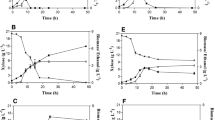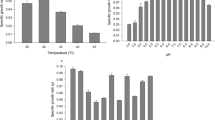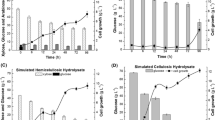Abstract
The search for new microbial strains that are able to withstand inhibitors released from hemicellulosic hydrolysis and are also still able to convert sugars in ethanol/xylitol is highly desirable. A yeast strain isolated from sugarcane juice and identified as Meyerozyma guilliermondii was evaluated for the ability to grow and ferment pentoses in synthetic media and in sugarcane bagasse hydrolysate. The yeast grew in xylose, arabinose and glucose at the same rate at an initial medium pH of 5.5. At pH 4.5, the yeast grew more slowly in arabinose. There was no sugar exhaustion within 60 h. At higher xylose concentrations with a higher initial cell concentration, sugar was exhausted within 96 h at pH 4.5. An increase of 350 % in biomass was obtained in detoxified hydrolysates, whereas supplementation with 3 g/L yeast extract increased biomass production by approximately 40 %. Ethanol and xylitol were produced more significantly in supplemented hydrolysates regardless of detoxification. Xylose consumption was enhanced in supplemented hydrolysates and arabinose was consumed only when xylose and glucose were no longer available. Supplementation had a greater impact on ethanol yield and productivity than detoxification; however, the product yields obtained in the present study are still much lower when compared to other yeast species in bagasse hydrolysate. By the other hand, the fermentation of both xylose and arabinose and capability of withstanding inhibitors are important characteristics of the strain assayed.

Similar content being viewed by others
References
Alves LA, Felipe MGA, Silva JBAE, Silva SS, Prata AMR (1998) Pretreatment of sugarcane bagasse hemicellulose hydrolysate for xylitol production by Candida guilliermondii. Appl Biochem Biotechnol 70–72:89–98
Amorim HV, Lopes ML, Oliveira JVC, Buckeridge MS, Goldman GH (2011) Scientific challenges of bioethanol production in Brazil. Appl Microbiol Biotechnol 91:1267–1275. doi:10.1007/s00253-011-3437-6
Antunes FAF, Milessi TSS, Chandel AK, Moraes VP, Rosa CA, Silva SS (2013) Evaluatin of a new yeast from Brazilian biodiversity Scheffersomyces shehatae UFMG-HM 52.2, for pentose sugars conversion into bioethanol. Biochem Biotechnol Rep 2(4):1–7. doi:10.5433/2316-5200.2013v2n4p1
Araujo FV, Soares CA, Hagler AN, Mendonça-Hagler LC (1995) Ascomycetous yeast communities of marine invertebrates in a southeast Brazilian mangrove ecosystem. Antonie Van Leeuwenhoek 68:91–99
Bolen PL, Detroy RW (1985) Induction of NADPH-linked d-xylose reductase and NAD-linked xylitol dehydrogenase activities in Pachysolen tannophilus by d-xylose, l-arabinose or d-galactose. Biotechnol Bioeng 27:302–307
Cadete RM, Santos RO, Melo MA, Mouro A, Gonçalves DL, Stambuk BU, Gomes FCO, Lachance MA, Rosa CA (2009) Spathaspora arboriae sp. nov., a d-xylose fermenting yeast species isolated from rotting wood in Brazil. FEMS Yeast Res 9:1338–1342. doi:10.1111/j.1567-1364.2009.00582.x
Cadete RM, Melo MA, Dussan KJ, Rodrigues RCLB, Silva SS, Zilli Vital MJS, Gomes FCO, Lachance MA, Rosa C (2012) Diversity and physiological characterization of d-xylose- fermenting yeasts isolated from the Brazilian Amazonian forest. PLoS One 7:1–11. doi:10.1371/journal.pone.0043135
Canettieri EV, Silva JBA, Felipe MGA (2002) Obtenção biotecnológica de xilitol a partir de cavacos de eucalipto. Braz J Pharm Sci 38(3):323–331
Canilha L, Carvalho W, Felipe MGA, Silva JBA, Giulietti M (2010) Ethanol production from sugarcane bagasse hydrolysate using Pichia stipitis. Appl Biochem Biotechnol 161:84–92. doi:10.1007/s12010-009-8792-8
Capriotti A, Ranieri L (1964) Yeasts in green house environment I. From soil, flowers and animals. Arch Mikrobiol 48:325–331
Carneiro LM (2011) Avaliação de estratégias de adaptação da levedura Pichia stipitis em hidrolisado hemicelulósico de palha de arroz visando a produção de etanol. Dissertation, Escola de Engenharia de Lorena-Universidade de São Paulo
Chandel KA, Chandrasekhar G, Radhika K, Ravinder R, Ravindra P (2011) Bioconversion of pentoses sugar into ethanol: a review and future directions. Biotechnol Mol Biol Rev 6:8–20
Coda R, Rizzello CG, Di Cagno R, Trani A, Cardinali G (2013) Antifungal activity of Meyerozyma guilliermondii: identification of activity compounds synthesized during dough fermentation and their effect on long-term storage of wheat bread. Food Microbiol 33:243–251. doi:10.1016/j.fm.2012.09.023
Diriye FU, Giansante C, Scorzetti G, Zilli R (1993) Indagine preliminare sulla ecologia dei lieviti delle acque del litorale Abruzzese. Ann Fac Agr Perugia XLV:339–345
Felipe MGA, Vieira DC, Vitolo M, Silva SS, Roberto IC, Mancilha IM (1995) Effect of acetic acid on xylose fermentation to xylitol by Candida guilliermondii. J Basic Microbiol 35(3):171–177
Gonçalves BMG, Jesus JYFM, Peron HB, Freitas WLC, Pagnocca FC, Silva SS (2013) Consumo de açúcares e ácido acético durante a destoxificação biológica de hidrolisado hemicelulósico pela levedura Issatchenkia occidentalis. Biochem Biotechnol Rep 2(3):372–375
Gong CS, Cao NJ, Du J, Tsao GT (1999) Ethanol production from renewable resources. Adv Biochem Eng Biotechnol 65:207–241
Guo D, Dai MI, Zhou ZP (2012) Molecular identification and morphological analysis of yeast in spoiled orange juice. Food Sci 33(9):131–137
Hähn-Hagerdal B, Linden T, Senac T, Skoog K (1991) Ethanolic fermentation of pentoses in lignocellulose hydrolysate. Appl Biochem Biotechnol 28–29(1):131–144
Helle S, Cameron D, Lam J, White B, Duff S (2003) Effect of inhibitory compounds found in biomass hydrolysates on growth and xylose fermentation by a genetically engineered strain of S. cerevisiae. Enzyme Microb Technol 33:786–792
Kern M, Haltrich D, Nidetzky B, Kulbe KD (1997) Induction of aldose reductase and xylitol dehydrogenase activities in Candida tenuis CBS4435. FEMS Microbiol Lett 149:31–37
Kumar A, Singh LK, Ghosh S (2009) Bioconversion of lignocelulosic fraction of water-hyacinth (Eichhornia crassipes) hemicelulose acid hydrolysate to ethanol by Pichia stipitis. Bioresour Technol 100:3293–3297. doi:10.1016/j.biortech.2009.02.023
Laluce C, Schenberg ACG, Gallardo JCM, Coradello LFC, Pombeiro-Sponchiado SR (2012) Advances and developments in strategies to improve strains of Saccharomyces cerevisiae and processes to obtain the lignocellulosic ethanol—a review. Appl Biochem Biotechnol 166:1908–1926. doi:10.1007/s12010-012-9619-6
Lima JR, Gonçalves LRB, Brandão LR, Rosa CA, Viana FMP (2012) Isolation, identification and activity in vitro of killer yeasts against Colletotrichum gloeosporioides isolated from tropical fruits. J Microbiol 52:1–10. doi:10.1002/jobm.201200049
Martini C (2014) Isolamento, identificação e caracterização de linhagem de levedura quanto ao crescimento e fermentação utilizando meios sintéticos com pentoses e hidrolisado de bagaço de cana-de-açúcar. Thesis, Universidade Estadual Paulista Julio de Mesquita Filho
Martiniano S, Chandel AK, Soares LCSR, Pagnocca FC, Silva SS (2013) Evaluation of novel xylose-fermenting yeast strains from Brazilian forests for hemicellulosic ethanol production from sugarcane bagasse. 3 Biotech 3:345–352. doi:10.1007/s13205-013-0145-1
Matos ITSR, Cassa-Barbosa LA, Galvão RSM, Nunes-Silva CG, Astolfi-Filho S (2014) Isolation, taxonomic identification and investigation of the biotechnological potential of wild-type Meyerozyma guilliermondii associated with Amazonian termites able to ferment d-xylose. Biosci J 30(1):260–266
Miller GL (1959) Use of dinitrosalicylic acid reagent for determination of reducing sugar. Anal Chem 31:426–428. doi:10.1021/ac60147a030
Mouro A (2012) Fermentação de xilose e celobiose por leveduras isoladas da biodiversidade brasileira. Dissertation, Universidade Federal de Santa Catarina
Moutta RO (2009) Hidrólise ácida de palha de cana-de-açúcar para obtenção de hidrolisado hemicelulósico visando à utilização em processos de produção de bioetanol. Dissertation, Escola de Engenharia de Lorena
Náhlik J, Palatová M, Gírio F, Roseiro C (2003) Model identification and physiological control of xylitol production using Debaryomyces hansenii. Process Biochem 38(12):1695–1705
Nakayan P, Hameed A, Singh S, Young LS, Hung MH, Young CC (2013) Phosphate-solubilizing soil yeast Meyerozyma guilliermondii CC1 improves maize (Zea mays L.) productivity and minimizes requisite chemical fertilization. Plant Soil. doi:10.1007/s11104-013-1792-z
Olsson L, Hahn-Hagerdal B (1996) Fermentation of lignocellulosic hydrolysates for ethanol production. Enzyme Microb Technol 18:312–331. doi:10.1016/0141-0229(95)00157-3
Parajó JC, Dominguez H, Dominguez JM (1998) Biotechnological production of xylitol. Part 1: interest of xylitol and fundamentals of its biosynthesis. Bioresour Technol 65:191–201
Rao RS, Bhaddra B, Shivaji S (2008) Isolation and characterization of ethanol producing yeast from fruits and tree barks. Lett Appl Microbiol 47:19–24. doi:10.1111/j.1472-765X.2008.02380.x
Rao RS, Prakasham RS, Prasad KK, Rajesham S, Sarma PN, Venkateswar RL (2004) Xylitol production by Candida sp: parameter optimization using Taguchi approach. Process Biochem 39:951–956
Roberto IC, Mancilha IM, Sato S (1999) Influence of kLa on bioconversion of rice straw hemicellulosic hydrolysate to xylitol production. Bioprocess Eng 21:505–508
Shi NQ, Prahl K, Hendrick J, Cruz J, Lu P (2000) Characterization and complementation of a Pichia stipitis mutant unable to grow on d-xylose or Larabinose. Appl Biochem Biotechnol 84–86:201–215
Sibirny A (1996) Pichia guilliermondii. In: Wolf K (ed) Nonconventional yeasts in biotechnology. Springer, Berlin, pp 255–275
Silva CJ, Roberto IC (2001) Improvement of xylitol production by Candida guilliermondii FTI 20037 previously adapted to rice straw hemicellulosic hydrolysate. Lett Appl Microbiol 32(4):248–252
Souza AP, Leite DCC, Pattathil S, Hahn MG, Buckeridge MS (2012) Composition and structure of sugarcane cell wall polysaccharides: implications for second-generation bioethanol production. Bioenergy Res. doi:10.1007/s12155-012-9268-1
Sreenath HK, Jeffries TW (2000) Production of ethanol from wood hydrolyzate by yeast. Bioresour Technol 72:253–260. doi:10.1016/S0960-8524(99)00113-3
Acknowledgments
This work was supported financially by Instituto Nacional de Ciência e Tecnologia do Bioetanol—INCT do Bioetanol (FAPESP 2008/57908-6 and CNPq 574002/2008-1) and Coordenação de Aperfeiçoamento de Pessoal de Nivel Superior (fellowship grants to C. Martini and C. B. Codato). The authors are greatly indebted to Dr. Ines Conceição Roberto (EEL–USP) for the chromatographic analysis.
Author information
Authors and Affiliations
Corresponding author
Rights and permissions
About this article
Cite this article
Martini, C., Tauk-Tornisielo, S.M., Codato, C.B. et al. A strain of Meyerozyma guilliermondii isolated from sugarcane juice is able to grow and ferment pentoses in synthetic and bagasse hydrolysate media. World J Microbiol Biotechnol 32, 80 (2016). https://doi.org/10.1007/s11274-016-2036-1
Received:
Accepted:
Published:
DOI: https://doi.org/10.1007/s11274-016-2036-1




